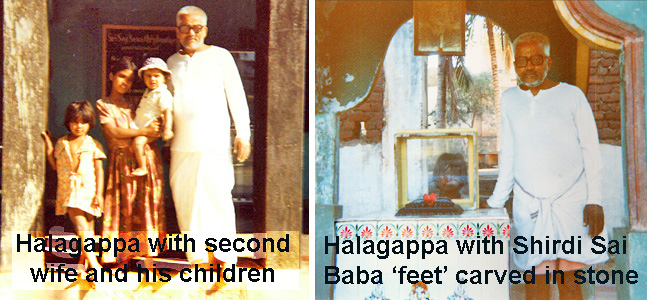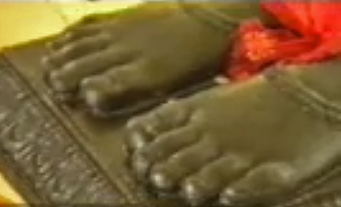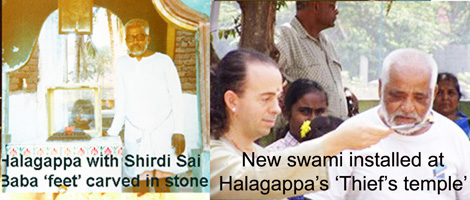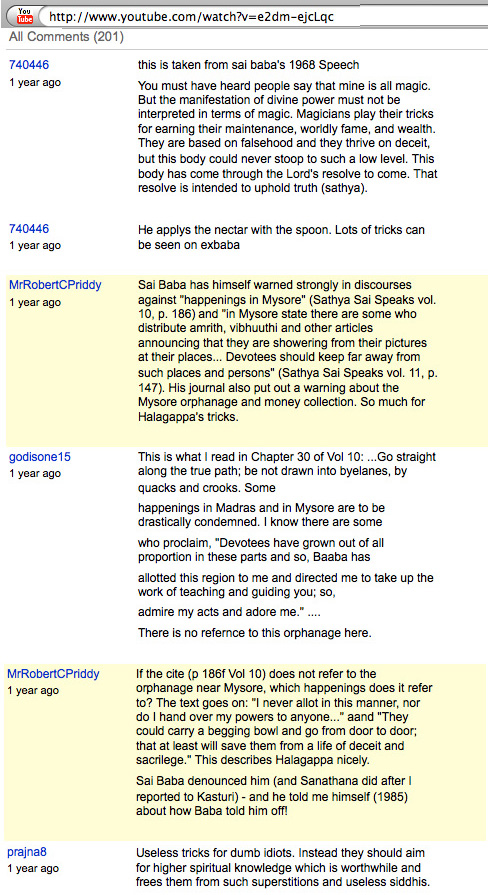

Sathya Sai Baba's liquid 'amrit' (i.e. 'holy nectar ') is a supposedly substance with a very distinctive odour. It can be collected from the doubtful 'Thief's Temple' in South India near Mysore, run by a man called Halagappa, a former thief who has two small amulets with Sai Baba's picture on - one given him by Sai Baba decades ago - that supposedly give off amrit into the jar in which they are kept. There was originally only the one amulet, but when visitor flow increased exponentially, suddenly there were two amulets! He told me how Sathya Sai Baba exposed him as the baggage thief he was and made him go to Mysore to start doing service looking after homeless children. He began to solicit donations for the temple based on reputed 'materializations' from a locked Sai Baba had once given him. He even often added sugar to vibuti (dried cow dung called 'holy ash' in India) to make it more acceptable. He threw out his first wife and took a young women instead, and so Sathya Sai Baba never visited him or spoke to him again.
Sai Baba was famed for dispensing 'holy amrit' to selected devotees, once even to a huge group at one time. The entire symbolism of the 'amrita' is very suspect… it comes from the mythological, ancient and fantastical Ramayana epic where -a goddess appears with a jar of it and gives it only to those fit to be divine beings (devas), while the rest are 'asuras' /akin to demons, who Sai Baba identified as the all those not blessed with faith (especially in himself). Those who did not succeed were consigned to countless more lifetimes as demonic 'asuras'. Sai devotees who get amrit are often of the opinion that they are past that, that are so blessed due partly to its sensory, culinary form, that their troubles are all over. It is often taken in Sai circles to mean that Sai Baba was lining one up for a healthy, happy, long life rounded off by liberation from rebirth. But I have seen the tragedies and even grisly ends of some of them. This is just the kind of substance to capitalize on among the countless suffering believers, the poor and needy not least.
Well, the recipe is simple sugar water with tea rose essence. The tea rose essence in very seldom met with, so it makes the amrit perfume/taste seem unique. Fantasizing wholly uncritical visitors talk of it being "definitely not of this world! ( R.D. Awle).
The liquid was analyzed and found to be sugar water, according to experts referred to on the Danish video 'Seduced' which caused such a furore in March 2002 in Denmark.
 Halagappa also had some feet carved in black stone on a pedestal, representing the deceased Shirdi Baba's feet under a small portico, which somehow exuded the tea-rose fragrant 'amrit' (sometimes referred to as 'nectar' or the Christian name 'ambrosia'). These symbolic 'feet' were installed there on Sai Baba's directions by N. Kasturi in the 1960s, Kasturi told me. Sai Baba said of (at least some of) the amrit he claims to have materialized that it indicates that the receiver will be free from the cycle of birth and death... liberated. Therefore, it is always spoken of by devotees as having an otherworldly fragrance, unique in every way, with unsurpassed sweetness and freshness etc. and is treated with reverence. When they finally taste some they believe they are thrice blessed and so on. Those who have smelt and tasted amrit, know its very distinctive taste and smell, a smell which cloys the more the older it gets. Left at room temperature it can turn rancid fairly soon, which should surely not be possible?
Halagappa also had some feet carved in black stone on a pedestal, representing the deceased Shirdi Baba's feet under a small portico, which somehow exuded the tea-rose fragrant 'amrit' (sometimes referred to as 'nectar' or the Christian name 'ambrosia'). These symbolic 'feet' were installed there on Sai Baba's directions by N. Kasturi in the 1960s, Kasturi told me. Sai Baba said of (at least some of) the amrit he claims to have materialized that it indicates that the receiver will be free from the cycle of birth and death... liberated. Therefore, it is always spoken of by devotees as having an otherworldly fragrance, unique in every way, with unsurpassed sweetness and freshness etc. and is treated with reverence. When they finally taste some they believe they are thrice blessed and so on. Those who have smelt and tasted amrit, know its very distinctive taste and smell, a smell which cloys the more the older it gets. Left at room temperature it can turn rancid fairly soon, which should surely not be possible?
Same with the amrit at Srirangapatnam 'orphanage'. This supposed 'orphanage' is also famous as 'The Thief's Temple' because its owner had famously once been caught out as a professional as a thief - a 'baggage lifter. He stole in Bangalore bus and train stations and also tried his luck on Sai Baba's followers at the ashrams too. Someone informed on him, no doubt, and so Sai Baba pointed him out in the crowd and accused him. (People believed this was SB's omniscience at work!). Halagappa told me he had been a thief himself, but proclaimed that he had mended his ways because Sai Baba told him to run an orphanage and get a temple built instead.
Apart from myself, all the reliable observers I have spoken to agree that the 'flow' of amrit from the amulets he shows is but a relative slow dribble due to the viscosity of the syrupy 'nectar', not lasting long at all. After 10 to 20 seconds, Halagappa scrapes away some of the liquid around the amulet with a spoon which has been in the amrit jar meantime, putting it in the other hand of the devotee to taste, and thus the flow get stronger as more amrit falls on the amulet from the near-vertical spoon. Halagappa does not allow it to rest on your hand more than a short time. Timing the period on videos we find anything from minimum 3 seconds to 10 seconds maximum before Halagappa introduces his spoon trick, and so the claims by some zealots of 'minutes of flow' is entirely unsubstantiated. The amulets may also well be hollow inside with thin concealed slits at top and bottom to allow it to hold more amrit, but the owner never allows genuine examination of either amulet (he limits it to seconds, not minutes)! You were never allowed to examine the amulet closely or on your own for more than a second or so, and the newcomer would have not enough suspicion to examine for such a scam. Knowing the degrees of ingenuity developed in this unrelenting society for deceiving people, and assuming that Halagappa was purposely defrauding his visitors, then he would not stop at using a hollow amulet to enhance the deception.
No one has produced a convincing video where the amulet is held for a long enough, steeply enough, for it either to run very long or to become become amrit-free, because Halagappa controls when it will be returned to the jar. Upon reflection, the whole thing was as suspicious as could be, when one thought about it thoroughly from all angles. But people are easily misled, as was I then. This happens because of enthusiasm, the tales from so many others and one's own hopes of some kind of tangible proof that the whole quest was not a wild goose chase. Most good people go there because of the opportunity it seemed to offer of doing something really worthwhile, as we all thought we were then. It is less a case of 'seeing is believing' than of 'believing is seeing', for the high expectation emotional mind-set affects one's judgement of what one sees, especially the time lapse. When mentally and emotionally stimulated (as devotees would be to see this for the first time) experimental psychology proves that time as subjectively perceived stretches out - it can even seem to stop sometimes. Timing each dribble between Halagappa's 'spoonings' with a stopwatch would soon settle that question.
The 'Seduced' film team were not able to test it properly, nor was scientist Dr. Narendra Nayak, who was refused entry altogether. One would think that a proper investigations would be very helpful to believers and scientists too, IF the phenomenon were no fraud. One is not allowed to dry it off and wait for a new flow, for example. Why?
Since any normal investigation was forbidden by Halagappa, the director of 'Seduced' used an experienced professional Danish illusionist/conjurer, Nils Krøjgaard, to demonstrate the fraud. See http://www.saibaba-x.org.uk/video/Amrit-clip 8.8 Mb .mov or http://www.saibaba-x.org.uk/video/Amrit_clip 9.3 Mb .mp4
He will do this several times, and the amazed or excited recipient does not take much notice of it if any, and would not think to question it feeling it might even be sacrilegious to do so (and most people want to be convinced and feel they are personally worth a divine blessing). Besides, everyone knows it is a big social sin in India to question a person so the lose face. Mr. Awle thinks he saw it running for "several minutes" while Hallagappa four times scooped away (!) the gathering liquid and put it into his other hand. Halagappa never waits for a minute, just 10 to perhaps even 20 seconds, until oozing slows or actually stops, when he scoops again with his suspicious large tablespoon. He also holds the person's hand so it is nearly horizontal, thereby making the flow last longer. This is all seen on films of the 'miracle' too. This trick is even seen on videos and the concave side of the amulet is even clearly towards the end. It is a clever deceit! A devotee of Sathya Sai Baba who lived permanently at Kadugodi (near the Brindavan ashram) claimed to know that Halagappa was manufacturing the vibuthi and amrit which appear there. (See here)
Then there are also 'feet of Shirdi Baba' - two foot- or sole- shaped forms carved in black stone which allegedly "sweats amrit". Why does Halagappa always stand nearby while one tests it? (There is such a thing as a simple hydraulic foot pump and, in India where life and death are both so uncertain, there is no end to the ingenuity of those who want to survive and prosper).
What happened to the miraculous vibuthi box Halagappa allegedly 'found' many years ago, which reportedly refilled itself when shaken? He is supposed to have stood and given vibuti to many people, shaking the box when it emptied. However, he told one of us it had stopped producing any more (Swami was angry with him for throwing out his wife and taking another)! Meanwhile, the Sai temple orphans wear rags & have no proper books or other facilities, while Halagappa's (second) wife wears diamonds and where the 'temple' has been marbled and beautified at great expense. Yet the donations made by visitors are truly enormous. The taxi firms are hand-in-glove with Halagappa too and bring many well-to-do foreigners there from Bangalore on day trips... One big scam!
That Halagappa lied to me pretending he was taken by his uncle to meet Shirdi Sai Baba is also certain. When first I met him I was willing to trust devotees' honesty, but I soon learned much greater circumspection. He said that Shirdi Sai cuffed him and he complained to his uncle who told him he was a fool, that it was a blessing which would cure him (of something). He told me his uncle asked Shirdi Sai to look after his nephew in future, and Shirdi Sai agreed. The literature reports that Shirdi Sai often hit people, and it was taken as a boon. Much later I checked back and worked out the dates. Shirdi Sai died in 1918, but when Halagappa told me this in 1985, he was about my age (then 50) and could not possibly have been 70 or more years old as he would have had to be ever to have met Shirdi Sai Baba. Had he been only 6 years then, he would have been 100 years of age now had he met Shirdi Sai in his very last months before death! So he exposed himself to me as a liar. The reason for such a lie is obvious, to try to establish his spiritual heritage back to the revered Muslim saint whose name Sathya annexed, thus explaining his strange career and Sathya Sai Baba's intervention. Many people would have fallen for that one!
Sai Baba has himself warned strongly in discourses against "happenings in Mysore and Madras" (Sathya Sai Speaks vol. 10, p. 186) and "in Mysore state there are some who distribute amrith, vibhuuthi and other articles announcing that they are showering from their pictures at their places... Devotees should keep far away from such places and persons" (Sathya Sai Speaks vol. 11, p. 147). Sanathana Sarathi also published a prominent warning against the Mysore/Sri Ranga Patna orphanage and unauthorised money collections there. So much for the genuineness of Halagappa's tricks and his collection of funds (another financial competitor to the Sai Central Trust!)
The image below shows a kind of plinth on which Professor Kasturi had installed this pair of black carved feet or 'footprints', supposedly those of the dead saint Shirdi Sai Baba, as he had been instructed by Sai Baba.  These feet apparently exude fragrant amrith (a concentrated tea rose liquid), which is most likely pumped by a foot lever by Halagappa. |
SMALL FORMAT VIDEO OF THE SPOON TRICKERY ETC. |
 |
Left image: the former baggage thief Halagappa beside the plinth with 'carved feet'. On the right, a 'new' swami turned up and acted as 'replacement' at the temple for ever-absent Sathya Sai Baba. |
The so-called "Sai amrit" with its distinctive 'perfume' consists mainly in sugar water with added tea rose essence (possible with a touch of jasmine or sandalwood essence in some cases). Perfumed tea roses come in several varieties and many variants of perfume are made from them and are marketed (as there is no longer a live link on-line, see here)
See scientific (electrospectrograph) analysis of vibuthi taken from Halagappa's temple - ordinary quartz crystal power. (18.1 Mb mov format)
At least one other prominent devotee of Sai Baba accused Halagappa of outright fraud (see here).
In a discussion on a YouTube video which promoted Halagappa's temple and its alleged miracles, the following exchanges took place:-
 |
 |